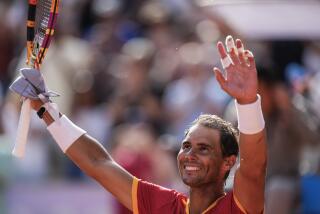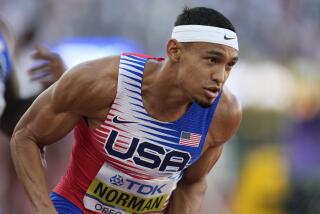No. 1 Has Nice Ring for Norman
- Share via
Who’s on first?
Old routine, new face. Even Abbott and Costello might have had a giggle at their aged shtick applied to men’s tennis. Who, indeed?
And the name rising from the crimson dust when the Italian Open ended last month was that of Magnus Norman, the greatest player in the history of Filipstad, Sweden.
Yes, Magnus Norman, nudging aside a Las Vegas landmark called Agassi.
Who? Why? Norman himself was laughing after dethroning Brazilian Gustavo Kuerten to win the title, and how many Swedish tennis players have you caught in a guffaw?
Norman, successor at No. 1 to countrymen Bjorn Borg (1979-80), Mats Wilander (1988) and Stefan Edberg (1990-91), is a different kettle of herring. A small-town guy who went through the give-and-take of team sports before making tennis his profession, he is somewhat mystified, as you too may be, by his recent rise.
“I didn’t think this [ranking] system was a good idea when the season started,” he says. “I’m not the best player in the world. That’s Andre [Agassi] or Pete [Sampras]. Don’t compare me with them. But I guess I have to get used to No. 1. For a while.”
Welcome to the brave-yet-confusing new world of the ATP Champions Race, the latest method of keeping track daily of who’s on first, like baseball or basketball.
That doesn’t mean 27-year-old “Blinky,” the ATP computer at Ponte Vedra Beach, Fla., has been retired. “Blinky,” however, has been relegated to a secondary role. He still dictates a pecking order, a rolling rating based on 12 months of performance. However, now it’s called the Entry List, which determines who may enter a tournament and if he will be seeded.
Much simpler is the Champions Race, calculable with pencil and paper, since everybody started at zero in January. No need for “Blinky.” Just win matches, add the point value for each--depending on the importance of the event--and you and the fans know your place in the standings.
Thus everybody is leading a double life, except Yevgeny Kafelnikov, No. 4 across the board. Norman, 29, marched into Paris this week as the drum major at the head of the parade. But he was seeded third, behind the second- and third-ranked players, Agassi and Sampras, because of their superior status on the Entry List.
Alex Corretja, victor at Indian Wells, says he didn’t care for the new setup either.
“But the race is becoming clearer, and Norman right now deserves to be No. 1,” he said.
After Sampras’ five-set loss in the first round to Mark Philippoussis and Agassi’s 2-6, 7-5, 6-1, 6-0 defeat against Karol Kucera in the second round Thursday, more tennis observers might agree with Corretja.
Norman breezed through the first two rounds, defeating Thierry Guardiola, 6-4, 6-4, 6-0, on Wednesday and Fabrice Santoro, 6-1, 6-4, 6-2, on Thursday.
His 38-11 match record makes him the game’s leading winner this year.
“It won’t make any difference at home unless I win the tournament--but I think I can,” he said. “I think I’m strong enough mentally and physically.”
A lanky, outgoing 6-foot-2 fugitive from hockey, Norman says, “Well, the Swedish press finally woke up from the dead when I moved into No. 1 ahead of Agassi.”
That happened with a semifinal win in Rome over green Aussie teenager Lleyton Hewitt, a couple of days after Agassi had lost in the third round to Dominik Hrbaty.
“I got a few calls from reporters. But I haven’t seen one on the tour in a long time,” Norman said.
“Even when I got to the semis of the Australian Open in January, my best result until Rome, nobody was interested. I guess you have to win majors to wake them up. Maybe they were spoiled by Borg, Edberg and Wilander.”
Matt Brown, a free-lance radio reporter on the international scene, phoned several prominent Swedish stations after Norman’s triumph at Rome, and reported, “No sales. A local kid. Amazing.”
Even so, Norman did lift the Swedes to the 1998 Davis Cup over Italy.
“We’d won it before,” he says, shrugging. “Nobody was too impressed. But that’s OK. I’m having a good time, and getting better.”
Norman was fair at hockey, but a national team player of bandy, a Scandinavian game related to hockey but substituting a tennis ball for the puck. Then he traded a crooked stick for a racket, his slap shot for a two-fisted backhand.
“I came to Rome looking for a girlfriend, but no luck there,” he said last month in Italy, offering a false frown. “Maybe it’s my hair,” sandy and sticking out in all directions. “I’ve tried everything. What do I call this style? ‘Disaster.’ Had to settle for a trophy. But I’m still looking for a girlfriend. Trouble is, I’m not in one place long enough.”
Although Norman tied Sampras and Agassi for most titles last year with five, his didn’t glitter as theirs did, and widespread publicity didn’t accompany them. But his exploits had a more exotic ring: victories at Shanghai; Umag, Croatia; Orlando, Fla.; finalist at Ostrava, Czech Republic.
At Wimbledon--”I’m amazed myself!”--Norman, clay born-and-bred, found nirvana.
“I left there last summer as the new Magnus Norman,” he says. “It happened when I beat Fabrice Santoro in the second round. I started hitting the ball early. You have to on grass. And it felt good. Something clicked. I’ve been doing it ever since.”
That approach differs from the usual baseline-hugging European and Latin dirt kickers. Norman takes the ball sooner, and from inside the baseline whenever he can, the Agassi-style Ping Pong. It kept Kuerten running at Rome, trying to do too much to the ball with too little time. Kuerten reversed the outcome the next week at Hamburg, defeating Norman in the quarterfinals.
But don’t underrate that win over Santoro at Wimbledon. After all, Santoro, now ranked No. 19, also was No. 1--for a week, the first week of the Champions Race. Hewitt took over for two, then Kafelnikov for four before the logical boss, Agassi, stepped in.
“I felt pressure when the chance, with Agassi beaten, for me to go up from No. 4 to No. 1,” Norman says. “I was relieved to beat Hewitt and grab the chance. Now I’ve shown myself I can win a big title over a big player [Kuerten]. That’s very important.”
It apparently went over better at Filipstad, a settlement of 10,000 known for its bakeries and a Swedish hard bread, than elsewhere in Sweden.
“I consider myself a goodwill ambassador for my town, a very good place,” Norman says.
Unless he goes stale, Norman, the town’s principal breadwinner and booster, could put the community on the international map. Suppose he kept No. 1 right down to the November wire? Wouldn’t that give him a huge last laugh when the “Who’s on first?” act played again?
(BEGIN TEXT OF INFOBOX / INFOGRAPHIC)
ATP Champions Race
Top ten of the ATP Champions Race 2000, through Monday (PR=Previous ranking; TP=Tournaments played):
*--*
No. Player, Country PR Pts TP 1. Magnus Norman, Sweden 1 346 12 2. Gustavo Kuerten, Brazil 2 305 10 3. Andre Agassi, U.S. 3 267 8 4. Yevgeny Kafelnikov, Russia 4 241 13 5. Lleyton Hewitt, Australia 5 239 9 6. Pete Sampras, U.S. 6 225 7 7. Cedric Pioline, France 7 219 10 8. Alex Corretja, Spain 8 217 9 9. Marat Safin, Russia 9 199 13 10. Thomas Enqvist, Sweden 10 180 11
*--*
More to Read
Go beyond the scoreboard
Get the latest on L.A.'s teams in the daily Sports Report newsletter.
You may occasionally receive promotional content from the Los Angeles Times.










